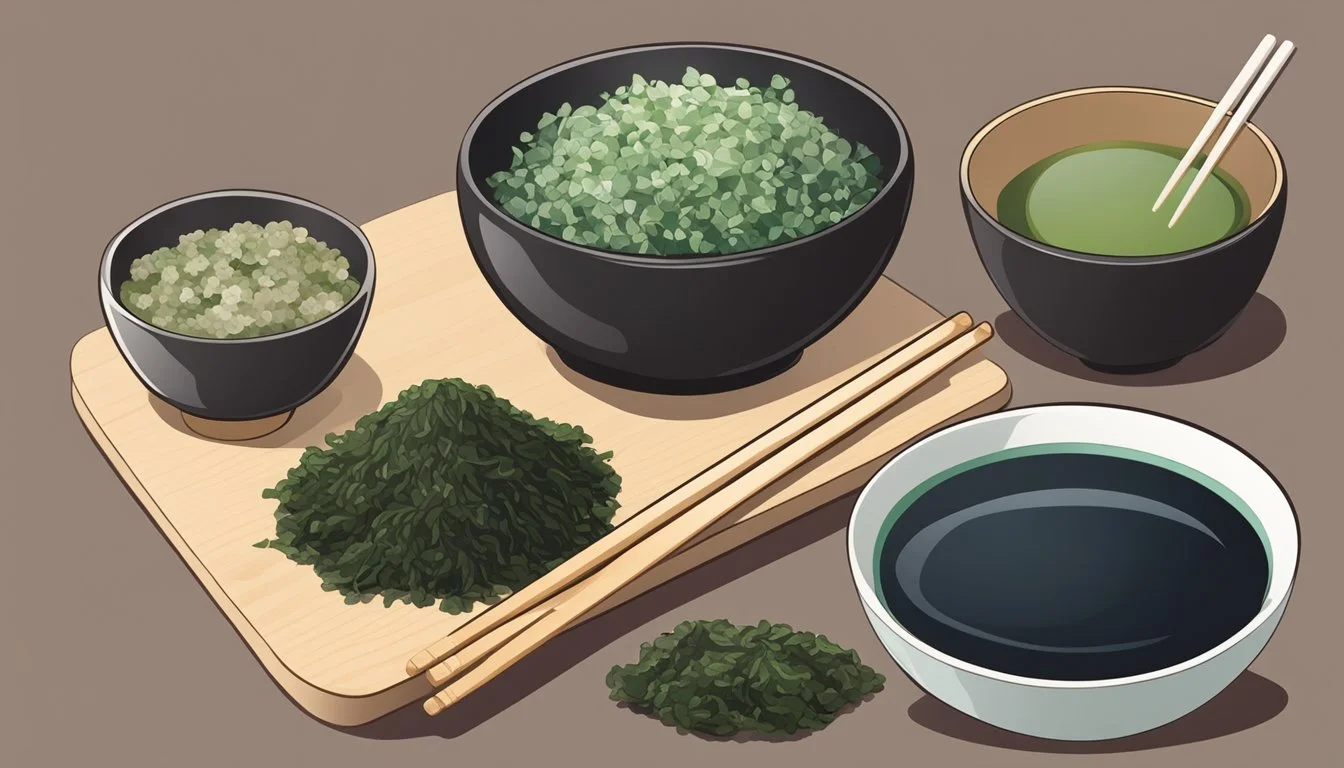Kombu Substitutes
Best Alternatives for Japanese Cooking
Kombu, a type of seaweed, is renowned for its ability to impart a distinct umami flavor in Japanese cuisine, particularly in the preparation of dashi broth. Whether you're out of kombu or seeking alternatives for dietary reasons, there are several substitutes that can achieve a similar depth of flavor. One of the most effective substitutes for kombu in dashi is shiitake mushrooms, which offer a rich umami profile.
Other substitutes include chicken stock, which can provide the necessary glutamic acid that creates umami notes, making it perfect for stews and soups. Additionally, options like hondashi, mentsuyu, and even soy sauce can quickly enhance the umami flavor in various dishes. These alternatives not only offer convenience but also versatility in different types of recipes.
Understanding Kombu
Kombu is a versatile seaweed known for its strong umami flavor and significant health benefits. It is commonly used to make dashi broth and rich soup stocks.
Kombu Nature and Uses
Kombu, a type of edible kelp, is an essential ingredient in Japanese cuisine. It imparts a unique umami flavor, making it indispensable in the preparation of dashi broth. Dashi serves as the base for many soups, stews, and sauces.
Kombu can be used in various forms, including dried strips, powdered granules, or fresh pieces. It's often added to soups and stocks to enhance flavor. Beyond traditional Japanese dishes, chefs worldwide incorporate kombu to introduce depth and complexity to their recipes.
Health Benefits of Kombu
Kombu is packed with nutrients, including Vitamins B and D. It's particularly high in iodine, a mineral essential for proper thyroid function. Additionally, kombu provides calcium, iron, magnesium, and other vital minerals that support overall health.
Antioxidants found in kombu help combat oxidative stress, aiding in disease prevention and promoting longevity. The seaweed's soluble fiber content also supports digestive health. Regular consumption of kombu can contribute to maintaining a balanced diet and enhancing overall wellness.
Kombu Substitutes Overview
When looking to replace kombu, it is essential to focus on ingredients that deliver a similar umami flavor. Key alternatives, such as other seaweeds, shiitake mushrooms, and bonito flakes, can effectively mimic the glutamic acid content and taste profile of kombu.
Criteria for Substitutes
The primary criterion for selecting a kombu substitute is the ability to impart umami flavor. Kombu's high content of glutamic acid, a type of glutamate, is responsible for this taste, known for creating a savory depth in dishes.
Compatibility with the intended dish is also crucial. For example, substitutes should be versatile enough to fit into broths, soups, or sauces without altering the desired consistency or overall flavor profile significantly.
Popular Kombu Alternatives
Other Seaweeds: Wakame and nori are excellent substitutes. They provide a similar flavor profile and are particularly effective in soups and stews. Wakame is especially noted for its consistency and taste in broths.
Shiitake Mushrooms: Dried shiitake mushrooms offer a rich umami flavor, thanks to their natural glutamate content. They are suitable for broths, soups, and even stir-fries. Soaking the mushrooms in water can further enhance their flavor profile, making them a versatile alternative.
Bonito Flakes: These flakes are made from dried, fermented fish and can replicate the umami richness of kombu. Bonito flakes are frequently used in Japanese cuisine and are ideal for creating dashi, a broth made by combining flakes with water.
Other common substitutes include chicken broth and mentsuyu, a Japanese seasoning that contains kombu-based dashi. Chicken broth, in particular, can be a convenient alternative when traditional Japanese ingredients are not readily available.
Substitutes from the Sea
When looking to replace kombu in recipes, various sea vegetables and marine options can provide the desired umami flavor. These substitutes help maintain the depth and complexity of your dish.
Seaweed Variants as Substitutes
Wakame Seaweed is a popular alternative to kombu. It has a mild sweetness and works well in soups and salads. To use, soak it in water for about 10 minutes to rehydrate, then add it to your dish.
Dulse is another excellent substitute. This reddish seaweed has a unique flavor that is both salty and slightly smoky. It can be used in broths and as a garnish.
Hijiki Seaweed offers a different texture and flavor profile. It has a strong, earthy taste and is typically used in salads and side dishes. Hijiki needs to be soaked and cooked before consumption.
Using Fish and Shellfish
Bonito Soup Stock (Katsuobushi) provides a potent umami flavor similar to kombu. Made from dried, fermented tuna, it’s commonly used in Japanese cuisine to make dashi. It can be added directly to broths.
Fish Sauce is a liquid condiment made from fermented fish. It offers a robust, salty umami flavor and can be used in small quantities to replace kombu in savory dishes.
Shellfish, such as clams or shrimp, can also be used to create a rich, flavorful broth. Simmer the shellfish with other ingredients to extract their natural flavors, creating a deep and savory base for soups and sauces.
Plant-Based Substitutes
Replacing kombu with plant-based alternatives can be a great way to retain the desired umami flavor in your dishes. Below are some excellent substitutes that offer similar taste profiles and versatility in cooking.
Mushroom-Based Substitutes
Dried Shiitake Mushrooms are an exceptional alternative to kombu. They are rich in umami due to their high levels of glutamate and can be used to make stocks, broths, and soups. Simply rehydrate the mushrooms in water and use the soaking liquid as you would use kombu-infused water. Additionally, the softened mushrooms can be diced and added to various dishes for extra flavor and texture.
Mushroom Powder is another useful substitute. Made from dried mushrooms ground into a fine powder, it can be easily sprinkled into soups, sauces, and stews. Mushroom powder provides a concentrated umami punch and is convenient to store and use.
Other Produce Options
Dried Tomatoes can also be used to replace kombu. Their concentrated flavors and glutamate content enhance the umami profile of dishes. Soak the dried tomatoes in warm water and use the resulting liquid in place of kombu broth. The rehydrated tomatoes can be chopped and added to dishes as well.
Soy Sauce and Marmite are great for adding umami. While not direct substitutes, a teaspoon of soy sauce or a small amount of Marmite can mimic the depth of flavor that kombu brings to broths and sauces.
When using these substitutes, adjust the quantities based on your taste preferences and the specific dish you are preparing.
Meat and Poultry Broths
Meat and poultry broths are effective substitutes for kombu, infusing dishes with rich umami flavors. These broths can be used in a variety of recipes, from stews to soups.
Beef Broth for Depth
Beef broth provides a rich, deep flavor that stands out in dishes requiring a sturdy umami base. Made by simmering beef bones, meat, and vegetables, beef broth contains high levels of glutamic acid. This compound is key to replicating the umami flavor that kombu provides.
When substituting kombu with beef broth, it’s important to consider the strong taste. It might overpower other ingredients if not balanced well. Beef broth works excellently in hearty stews, rich soups, and braises, providing depth and complexity.
For those needing a vegetarian alternative, Monosodium Glutamate (MSG) seasoning can be used to simulate the umami notes found in beef broth. Yet, nothing replicates the fullness that a well-made beef broth brings to a dish.
Using Chicken Stock
Chicken stock is another versatile substitute when kombu is unavailable. It’s made by slowly simmering chicken bones, meat, and herbs, producing a lighter but still flavorful broth rich in umami. The glutamic acid present in chicken stock enhances the savory qualities of dishes similarly to kombu.
This broth is excellent in lighter recipes like noodle soups, where it provides a savory yet subtle flavor. It’s easier to find than kombu, making it a convenient alternative. Be mindful of the salt content; chicken stock can sometimes be saltier than homemade broths.
Chicken broth can also be used, though it may lack the richness of a well-made stock. Both types offer a practical and flavorful way to incorporate the desired umami profile into your cooking.
Commercial Flavor Enhancers
Commercial flavor enhancers offer convenient and effective ways to replicate the umami-rich taste of kombu. These products include both granules and powders, as well as brand-specific flavor agents designed to enhance various dishes.
Granules and Powders
Granules and powders are easy to use and widely available. MSG (Monosodium Glutamate) is a key ingredient, often marketed under brand names like Ajinomoto. MSG enhances the savory notes in dishes, mimicking the umami flavor found in kombu.
Another option is Kombu Granules and Kombu Powder, which are made from dehydrated kombu. They are particularly useful in broths and soups, providing a concentrated umami boost. For Japanese cuisine, Hondashi and Mentsuyu are popular powdered broth bases that include kombu extracts and other flavor enhancers, often used in miso soup and noodle dishes.
Brand-Specific Flavor Agents
Brands like Ajinomoto offer formulated products such as Ajinomoto Salt, which combines MSG with other seasonings. This product aims to provide a balanced umami flavor while adding saltiness to the dish.
Uy Granules is another specialized product that offers a unique umami profile, often used in soups and stews. Kombu Powder products by specific Japanese brands are formulated to dissolve easily, making them ideal for quick applications in miso soup and other traditional recipes.
Many of these brand-specific flavor agents are designed to replicate the natural taste of kombu, ensuring a consistent and authentic flavor experience.
Creative Cooking with Kombu Substitutes
Utilizing kombu substitutes can enhance your culinary creations with the rich, savory flavor known as umami. Whether infusing soups or adjusting specialty dishes, these substitutes offer versatile and flavorful options.
Infusing Umami in Soups
Kombu substitutes like chicken broth or beef broth are excellent for infusing umami in soups. They provide a similar depth of flavor, making them ideal for clear Japanese soups and tofu soup.
For a fish-based alternative, white fish like cod can be simmered to create a broth rich in umami. Bonito flakes are another popular substitute, especially in making dashi. These smoked, dried fish flakes dissolve easily, imparting a profound umami taste to udon noodles and ramen.
When using these substitutes, adjust the quantity to match the desired flavor intensity. A 1:1 ratio works well for broth-based recipes, while bonito flakes should be used sparingly due to their potent flavor.
Adjusting Umami in Specialty Dishes
In specialty dishes, kombu substitutes can elevate the umami profile without overpowering other flavors. Dried mushrooms like shiitake offer a vegetarian-friendly umami boost, perfect for stews and sauces.
For seasoning, soy sauce and fish sauce provide a salty, umami-rich kick. These can be integrated into ramen broths, stir-fries, and marinades. Mentsuyu, a Japanese condiment, combines dashi, soy sauce, and mirin, ensuring a balanced umami flavor.
When preparing dishes like tofu soup or udon noodles, mixing and matching these substitutes can achieve a nuanced umami profile. Use soy sauce or fish sauce in moderation to prevent the dish from becoming too salty.







